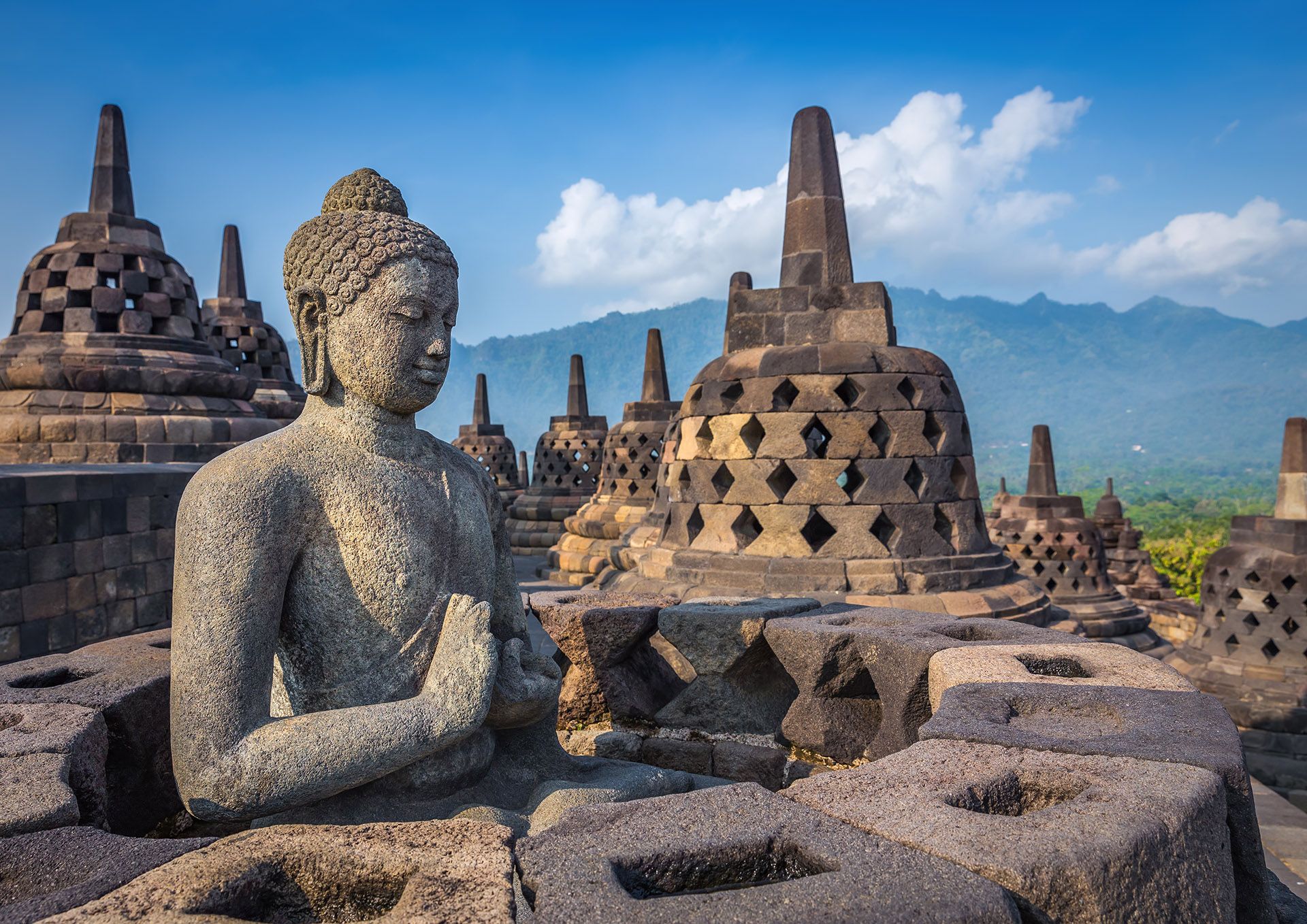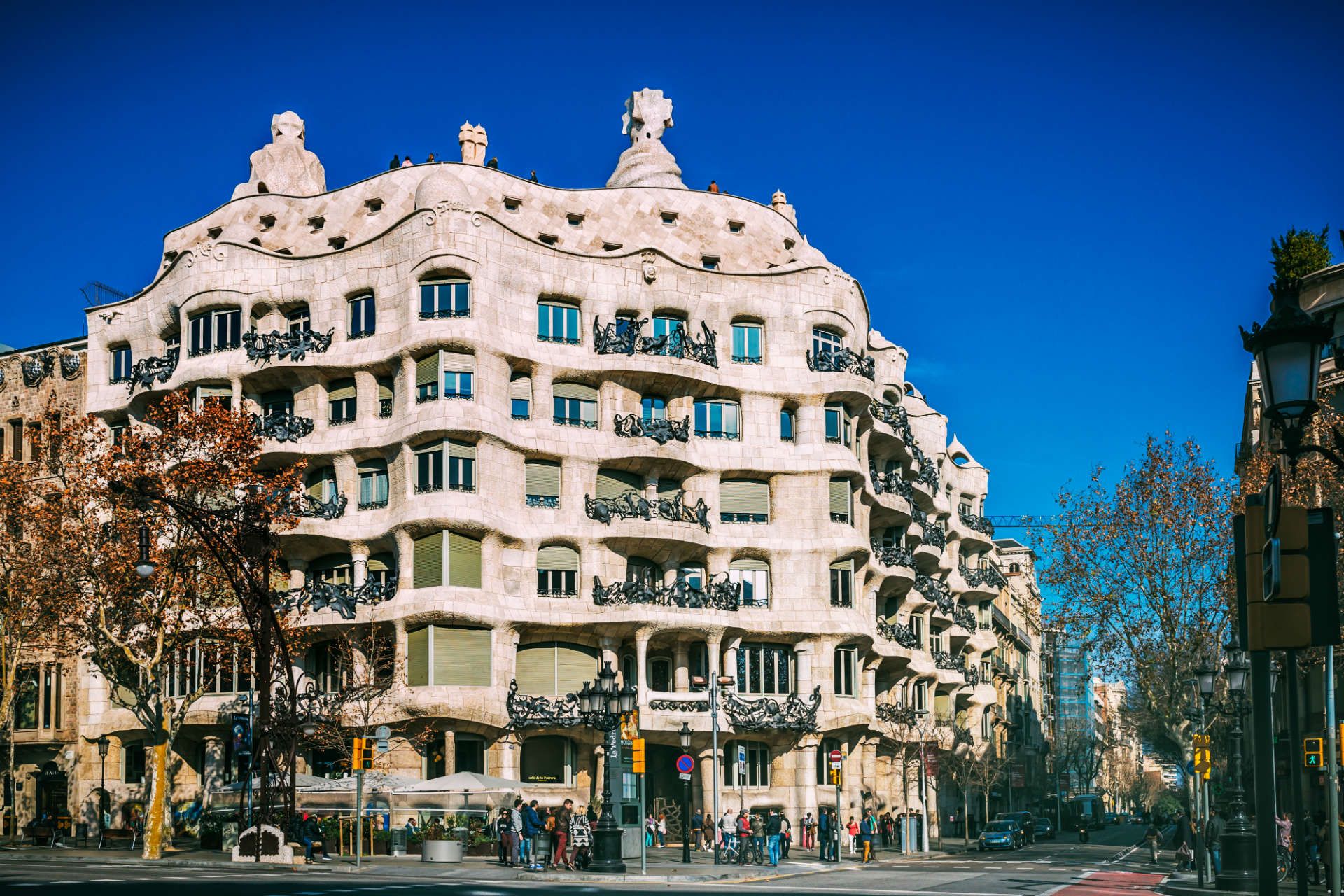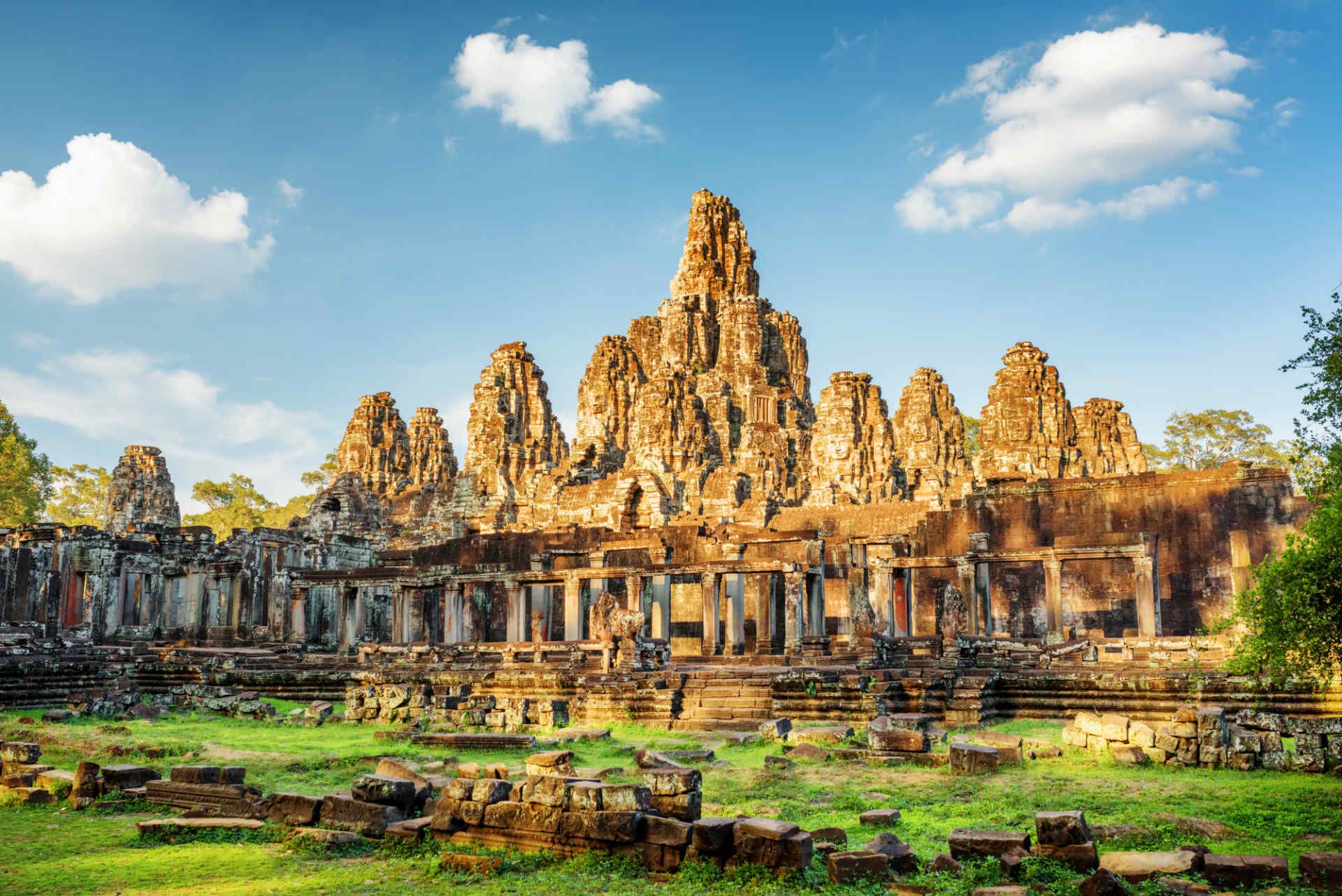Planning your own trip? Prepare for your trip
Use Rough Guides' trusted partners for great rates
Book your individual trip, stress-free with local travel experts
From ancient temples to hyper-modern skyscrapers, these are just a few of the world's most incredible architectural wonders. Whether you're looking to wander lost ruins or explore lavish palaces, you'll find inspiration here.
Towering out of an elm-wooded hillside above Granada, a snowy Sierra Nevada behind, there are few more iconic images of Spain than the ochre-tinted enclave of the Alhambra. Over five thousand visitors wander through the restored complex every day. No amount of words, however, can approximate the sensual charge of seeing the Palacios Nazaríes, the best preserved palace of the Nasrid dynasty, for the first time.

© Shutterstock
One of the wonders of the ancient world, the Roman archeological site of Baalbek – a place that, in the words of Robert Byron, “dwarfs New York into a home of ants” – holds awe-inspiring temples, porticoes, courtyards and palatial stone stairways. The Greeks and Romans called it Heliopolis, “The City of the Sun”, a name it shares with another great Classical city in Egypt – but this phenomenal site has no equals.

© Anton_Ivanov/Shutterstock
Dubai is a desert turned Disney. What was once a sleepy fishing village is now a futuristic cybercity, with sparkling skyscrapers, shopping malls, water parks, golf courses and hotels so flashy that Elton John would be proud to call them home. The iconic Burj Al Arab is a striking 28-storey symbol of new-world bling. One of the tallest hotels in the world, the gleaming building is built on an artificial island, 280m from the mainland, and is shaped like a huge billowing sail.

© Jack.Q/Shutterstock
Rising like a giant fist above the valleys of Oaxaca, magical, mystical Monte Albán is above all a statement of power. The Zapotecs built their city far from the valleys and without any natural water supply to emphasize their dominance of their people, and nature itself. What remains today is just the very centre of the site – the religious and political heart – and until you reach the top it’s impossible to appreciate the sheer audacity of this place.

© Dmitry Rukhlenko/Shutterstock
Discover undefined's most captivating stories
The great temples of the Chola dynasty utterly dominate most major towns in Tamil Nadu. For sheer scale and intensity, though, none outstrips the one dedicated to the fish-eyed goddess, Shri Meenakshi, and her consort, Sundareshwara, in Madurai. Peaking at 46m, the towers taper skywards like elongated, stepped pyramids, their surfaces writhing with an anarchic jumble of deities, demons, warriors, curvaceous maidens, pot-bellied dwarves and sprites – all rendered in Disney-bright colours.

© Val Shevchenko/Shutterstock
It’s hard to forget the first time you catch a glimpse of France's Château de Peyrepertuse. In fact, it takes a while before you realize that this really is a castle, not just some fantastic rock formation sprouting from the mountaintop. But it’s no mirage – 800 years ago, men really did haul slabs of stone up here to build one of the most hauntingly beautiful fortresses in Europe.

© midgardson/Shutterstock
It’s been a while since La Mezquita, or the Great Mosque, was used as such (1236 to be exact), but at one time it was not only the largest in the city but in all al-Andalus. Almost a millennium later, its hallucinatory interior still hushes the garrulous into silence and the jaded into awe, a dreamscape of candy-striped arches piled upon arches, sifting light from shadow.

© Matej Kastelic/Shutterstock
The city of Astana is the project of President Nursultan Nazarbayev, who has ruled Kazakhstan since the fall of the Soviet empire. A gilded imprint of his hand rests on the top of the Bayterek, a spiky space-age tower representing the poplar tree in which, according to legend, the magic Samuruk bird laid its egg. Yet this is only one of a number of statement buildings across this extraordinary city. Others include a glowing glass Pyramid of Peace designed by Norman Foster.

Bayterek Tower Nurzhol Bulvar in Astana, Kazakhstan © Anton Petrus/Shutterstock
It is said that if you visit all the mosques in Iran, you should visit the Masjid i-Imam last, as its beauty will supplant your memory of all others. Built over 26 years, the Safavid-era mosque sits on the southern edge of the Maydan Naqsh i-Jahan, a massive fountained square in central Isfahan. Stroll around the outside to take in the wild collection of diverse motifs, colours and calligraphic designs that adorn the various portals, walls and vaults. In the centre of it all is a beguiling, 54m-high bulbous dome.

Jame Abbasi mosque on Naqsh-i Jahan Square, Esfahan, Isfahan, Iran © Aleksandar Todorovic/Shutterstock
As befits a former royal residence, there’s bling aplenty at the Grand Palace, whose main temple, Wat Phra Kaeo, dazzles with its shimmering walls and gables covered all over in gilt and coloured glass mosaics. Join the hundreds of Thai pilgrims and step inside to pay homage to the teeny Emerald Buddha, the holiest icon in the country.

Wat Phra Kaeo, Temple of the Emerald Buddha Bangkok, Asia Thailand © apiguide/Shutterstock
A series of interconnected titanium-coated buildings make up Bilbao’s Guggenheim Museum, designed by Canadian–American architect Frank Gehry and opened in 1997 to an overwhelmingly positive reception. The museum’s opening revitalised Bilbao’s economy, bringing millions of visitors to see its groundbreaking, sculpture-like curved structure and the modern art exhibitions inside.

Guggenheim Museum in Bilbao, Spain © Tara LB/Shutterstock
At 634m high, the Tokyo Sky Tree is the tallest tower in the world and the second-tallest structure after Burj Khalifa. Construction of the epic broadcasting tower was completed in 2012, fusing futuristic design with traditional Japanese aesthetics. It’s painted in “Skytree White”, representing harmony with its environment, and at night is lit up with iki (“chic”) sky blue or miyabi (“elegant”) purple.

Tokyo skyline with Mt Fuji and Skytree, Japan © mapman/Shutterstock
The smooth, sleek curves of Beijing’s Giant Egg are beautifully reflected in the glass-like surface of the man-made lake that surrounds it. Built for the 2008 Summer Olympics, the gleaming dome, which looks as if it’s floating on the lake, contains an opera house, concert hall and theatre, all of which are accessed via a hallway underneath the water.
Built in 72AD and still the largest amphitheatre in the world, Rome’s most famous ancient monument has eighty entrances and can accommodate over 50,000 spectators. It took 60,000 Jewish slaves nine years to build, and hundreds of thousands of people died in its arena during the gladiator fights that took place here over nearly four centuries.

Rome from above aerial view of the Roman Forum and the Colosseum © Calin Stan/Shutterstock
Beijing’s iconic National Stadium, nicknamed the Bird’s Nest due to its intricate lattice steel design, was constructed using 36km of unwrapped steel, making it the largest steel structure in the world. The 42,000 tonnes of metal also house the world’s largest enclosed space, where the memorable opening and closing ceremonies of the 2008 Summer Olympics took place.

China National Olympic Stadium © Eastimages/Shutterstock
Since the first and only resident’s death in 1886, the once-home of Ludwig II of Bavaria has seen 60 million people pass through its doors. A glorious homage to the composer Wagner, and obedient to the architectural fashion of castle romanticism popular in Ludwig’s time, Neuschwanstein was the inspiration for Disney’s iconic Sleeping Beauty Castle, and immortalised in their logo.

Neuschwanstein Castle in Bavaria, Germany © VOJTa Herout/Shutterstock
Antoni Gaudí’s unfinished masterpiece was designed so it would stand no higher than the “God-made” structure of Montjuic hill; the central spire will be 170m – one metre less than the hill. Work began on the extraordinary church in 1882, and the completion date is set for 2026. Just eight of the eighteen planned spires have been built to date.

© Shutterstock
The most famous mausoleum in the world, Agra’s “crown of palaces” was built in 1653 for the wife of Emporer Shah Jahan. One of the Seven Wonders of the World, the white-marble building, identical on each of its four sides, transforms throughout the day, from pink in the morning light to milky white in the evening and golden under moonlight.

Taj Mahal, India © Don Mammoser/Shutterstock
Designed by Danish architect Jørn Utzon, Sydney’s most recognisable landmark and one of the most distinctive buildings of the twentieth century, the Opera House opened in 1973 after a spend of AUS$102 million – fifteen times over budget. The building’s “sails” were constructed using three tower cranes made in France specifically for the Opera House, costing AUS$100,000 each.

Sydney Harbor bridge and the Opera House in Sydney © ChameleonsEye/Shutterstock
Built for Expo ‘58, standing 102m high and with nine connected stainless steel spheres, the Atomium forms the shape of a cell of an iron crystal magnified 165 billion times. Created to symbolize peace among nations, a faith in scientific progress and a positive vision of the future, the bizarre-looking construction is now one of Brussels’ most iconic buildings.
Habitat 67 was a revolutionary housing concept designed for the Montréal Expo ‘67 by Israeli–Canadian architect Moshe Safdie. Comprised of 354 identical concrete units arranged on top of each other, the development upheld the concept of single family inner-city dwelling, but also brought in the benefits of suburban living, in which each dwelling has outdoor space, fresh air and privacy.
The world’s largest Buddhist temple was built over a thousand years ago in the Kedu Valley, Java. The elaborate construction was designed to take pilgrims on a journey through kamadhatu (the world of desires), represented by the temple’s base, rupadhatu (the world of forms), represented by the five square terraces and arupadhatu (the formless world), represented by the three circular platforms and stupa.

Borobudur, Java - Indonesia © Bule Sky Studio/Shutterstock
An apartment block like no other, Casa Milà is known as La Pedrera (“The Quarry”) due to its undulating stone exterior that curls its way around the building. Gaudí's innovative design included the first underground car park and an almost cornerless interior, in which everything from the walls to the bed-knobs is curved, giving the building a unique, enchanting fluidity.

© Shutterstock
Constructed in the early 12th century by the Khmer King Suryavarman II, Angkor Wat is the largest religious monument in the world. In the late 13th century, the temple gradually moved from Hindu to Buddhist use, as it is still used to this day. So integral is this immense temple to Cambodian identity that it appears on the national flag.

Travel Guide Cambodia Rough Guides - Main view of ancient Bayon temple Angkor, Cambodia © Efired/Shutterstock
The 88 storeys of the Petronas Towers, designed in an “M” shape to represent Malaysia, soar 452m into the Kuala Lumpur sky, connected by the highest double-decker bridge in the world, situated between the 41st and 42nd floors. Though you can walk across the bridge and take in some dizzying views, it was actually designed to stop the towers from breaking during high winds.

Petronas Tower © kudla/Shutterstock
Considered by the Guinness Book of Records to be the world’s largest palace, Istana Nurul, “The Palace of Light and Faith”, is the official residence of the Sultan of Brunei, Hassanal Bolkiah. The palace contains 1788 rooms, a 5000-capacity banquet hall, 1500-capacity mosque, a 110-car garage, 5 swimming pools and – naturally – an air-conditioned stable with 200 polo ponies.

Istana Nurul Iman, the official residence of the Sultan of Brunei © Matyas Rehak/Shutterstock
written by
Rough Guides Editors
updated 03.08.2021
For over 40 years, Rough Guides has been a trusted name in travel, offering expert-curated guides, inspiring articles, and tailor-made trips. Our passionate team of writers and local travel specialists provide in-depth insights into destinations worldwide, from iconic landmarks to hidden gems. We help you travel smarter and experience the world authentically.
Use Rough Guides' trusted partners for great rates
Discover undefined's most captivating stories
Arrange your trip, hassle-free, with local travel experts
Arrange your trip with local travel experts